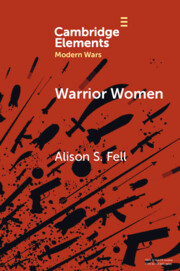Refine search
Actions for selected content:
15401 results in Military history
3 - “Gott mit uns”
-
- Book:
- Between God and Hitler
- Published online:
- 14 April 2023
- Print publication:
- 11 May 2023, pp 78-112
-
- Chapter
- Export citation
Introduction
-
- Book:
- Between God and Hitler
- Published online:
- 14 April 2023
- Print publication:
- 11 May 2023, pp 1-21
-
- Chapter
- Export citation
6 - “What Should We Preach Now?”
-
- Book:
- Between God and Hitler
- Published online:
- 14 April 2023
- Print publication:
- 11 May 2023, pp 172-202
-
- Chapter
- Export citation
5 - “The Power of Christian Truth and Christian Faith”
-
- Book:
- Between God and Hitler
- Published online:
- 14 April 2023
- Print publication:
- 11 May 2023, pp 147-171
-
- Chapter
- Export citation
Conclusion
-
- Book:
- Between God and Hitler
- Published online:
- 14 April 2023
- Print publication:
- 11 May 2023, pp 229-235
-
- Chapter
- Export citation
Note on the Text
-
- Book:
- Between God and Hitler
- Published online:
- 14 April 2023
- Print publication:
- 11 May 2023, pp xvii-xviii
-
- Chapter
- Export citation
Index
-
- Book:
- Between God and Hitler
- Published online:
- 14 April 2023
- Print publication:
- 11 May 2023, pp 313-326
-
- Chapter
- Export citation
Notes
-
- Book:
- Between God and Hitler
- Published online:
- 14 April 2023
- Print publication:
- 11 May 2023, pp 236-282
-
- Chapter
- Export citation
Acknowledgments
-
- Book:
- Between God and Hitler
- Published online:
- 14 April 2023
- Print publication:
- 11 May 2023, pp xiv-xvi
-
- Chapter
- Export citation
Table
-
- Book:
- Between God and Hitler
- Published online:
- 14 April 2023
- Print publication:
- 11 May 2023, pp viii-viii
-
- Chapter
- Export citation
7 - From Nazi Past to Christian Future
-
- Book:
- Between God and Hitler
- Published online:
- 14 April 2023
- Print publication:
- 11 May 2023, pp 203-228
-
- Chapter
- Export citation
Contents
-
- Book:
- Between God and Hitler
- Published online:
- 14 April 2023
- Print publication:
- 11 May 2023, pp v-v
-
- Chapter
- Export citation

Warrior Women
- The Cultural Politics of Armed Women, c.1850–1945
-
- Published online:
- 08 May 2023
- Print publication:
- 18 May 2023
-
- Element
- Export citation

Hitler's Panzer Generals
- Guderian, Hoepner, Reinhardt and Schmidt Unguarded
-
- Published online:
- 04 May 2023
- Print publication:
- 04 May 2023
Acknowledgements
-
- Book:
- Hitler's Panzer Generals
- Published online:
- 04 May 2023
- Print publication:
- 04 May 2023, pp xi-xii
-
- Chapter
- Export citation
Copyright page
-
- Book:
- Hitler's Panzer Generals
- Published online:
- 04 May 2023
- Print publication:
- 04 May 2023, pp iv-iv
-
- Chapter
- Export citation
Conclusion
-
- Book:
- Hitler's Panzer Generals
- Published online:
- 04 May 2023
- Print publication:
- 04 May 2023, pp 239-246
-
- Chapter
- Export citation
Bibliography
-
- Book:
- Hitler's Panzer Generals
- Published online:
- 04 May 2023
- Print publication:
- 04 May 2023, pp 291-310
-
- Chapter
- Export citation
2 - The Private Generals
-
- Book:
- Hitler's Panzer Generals
- Published online:
- 04 May 2023
- Print publication:
- 04 May 2023, pp 22-74
-
- Chapter
- Export citation
1 - The Letters of the Panzer Generals
-
- Book:
- Hitler's Panzer Generals
- Published online:
- 04 May 2023
- Print publication:
- 04 May 2023, pp 10-21
-
- Chapter
- Export citation
